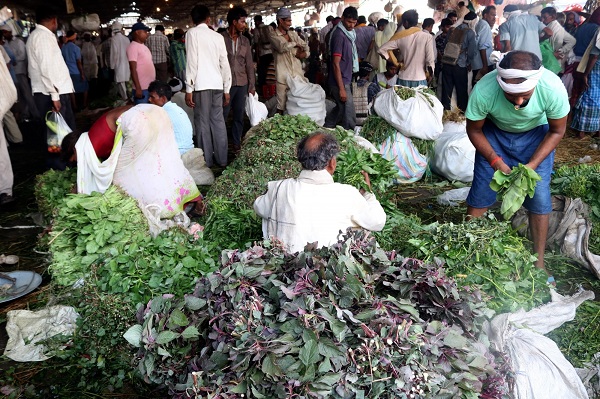New Delhi, (Samajweekly) India’s WPI Food Index eased to 2.31 per cent in May from a rise of 3.60 per cent in April, official data showed on Monday.
However, the Centre did not release the complete set of WPI figures for May, due to the Covid-19 outbreak and its impact on data collection.
Besides, the data showed that overall WPI recorded a fall of (-)3.21 per cent in May 2020 from a 0.42 per cent rise in March.
In a note, the Office of Economic Adviser, Department for Promotion of Industry and Internal Trade said: “Due to limited information available for the month of April 2020, the provisional figures of May 2020 are compared with final figures of March 2020.”
“The official Wholesale Price Index for ‘All Commodities’ (Base: 2011-12=100) for the month of May 2020 declined by (-2.24 per cent) to 117.7 (provisional) from 120.4 (Final) for the month of March 2020.”
On a sequential basis, the expenses on primary articles, which constitute 22.62 per cent of the WPI’s total weightage, declined (-)2.92 per cent in May from (-)0.79 per cent in April.
“The index for this major group declined by (-0.87 per cent) to 136.2 (provisional) in May 2020 from 137.4 (final) for the month of March 2020,” the statement said.
“Prices of ‘Food Articles’ (0.73 per cent) increased whereas prices of ‘Crude Petroleum & Natural Gas’ (-23.18 per cent) and ‘Non Food Articles’ (-1.44 per cent) declined as compared to March 2020.”
Furthermore, manufactured products’ WPI showed a decline of (-)0.42 per cent in May from 0.25 per cent in March.
The statement further said: “The index for this major group declined by (-0.42 per cent) to 118.1 (provisional) in May 2020 from 118.6 (final) for the month of March 2020.”
As per the statement, out of the 22 NIC two-digit groups for ‘Manufactured’ products, 10 groups that have witnessed increase in prices are manufacture of beverages; tobacco products; wearing apparel; leather and related products; wood and of products of wood and cork; paper and paper products; pharmaceuticals, medicinal chemical and botanical products; other non-metallic mineral products; motor vehicles, trailers and semi-trailers and other transport equipment.
“Whereas the groups that witnessed decrease in prices were manufacture of food products; textiles; printing and reproduction of recorded media; chemicals and chemical products; rubber and plastics products; manufacture of basic metals; fabricated metal products, except machinery and equipment; computer, electronic and optical products; electrical equipment; machinery and equipment as compared to March 2020,” the statement said.
The cost of the fuel and power category declined (-)19.83 per cent in May against a fall of (-)10.12 per cent in April and (-)2.93 per cent in March.
Product-wise, the price of high-speed diesel declined (-)30.02 per cent on a YoY basis, petrol deflated (-)27.89 per cent and LPG (-)28.63 per cent.
“The extent of the disinflation in the WPI in May 2020 was deeper than we had pencilled in,” said Aditi Nayar, Principal Economist, ICRA.
“While the rise in prices of some commodities like crude oil, may arrest the fall in the WPI going ahead, easing food price pressure portend a welcome moderation in retail food inflation.”
According to Suman Chowdhury, Chief Analytical Officer at Acuite Ratings and Research: “While data collation for inflation has been a challenge and no data for WPI or CPI was available for April, the broad based contraction in WPI across all the segments – primary articles, fuel and power and manufacturing, reflects the disruption in demand arising out of the Covid lockdown.”
“Given the supply bottlenecks that are expected to emerge as demand revives in the economy, Acuite believes it is difficult for the deflationary trend to sustain at the WPI level beyond the lockdown months. However, food inflation is likely to remain low going forward and should also translate to a moderation in CPI for food and beverages over the next few months.”
On last Friday, another set of data showed that India’s YoY consumer food price inflation at 9.28 per cent in May.
Nonetheless, the National Statistical Office did not share the full set of data on Consumer Price Index or retail inflation due to the outbreak of Covid-19 pandemic.
The CFPI’s readings measure change in retail prices of food product.
In sequential comparative terms, the CFPI reading rose in May to 151.9 from 1 51.7 in April, 2020.
In March, the food inflation had eased to 8.76 per cent, compared with 10.81 per cent recorded in February 2020 and 0.30 per cent in the corresponding period of last year.










